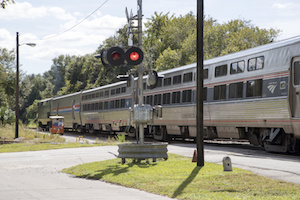The exclusion of expert evidence likely contributed to a not guilty verdict for a driver who was accused of causing a crash with an Amtrak train. Dana Naylor, Jr. was charged with involuntary manslaughter after an Amtrak train crashed into the garbage truck he was driving.
The crash occurred near Crozet, Virginia. A co-worker in Naylor’s truck was killed and another was injured. Some Republican legislators who had chartered the train suffered minor injuries.
The prosecution obtained a grand jury indictment before the National Transportation Safety Board (NTSB) completed its investigation of the accident. The NTSB recently released a document claiming that “video from the train shows the truck driving around the gates.” That video was not introduced as evidence at Naylor’s trial. Train operators, however, testified that Naylor drove around the barriers.
The defense contended that Naylor’s garbage truck was already on the track before the barriers came down. A defense witness who lives near the crossing testified that “safety arms at the crossing have malfunctioned in the past, and they don’t seem to activate with enough time when high-speed passenger trains are coming through.”
The NTSB and the waste disposal company that employed Naylor tried to recreate the accident by driving a similar garbage truck around the barriers. They discovered that it was impossible to drive the truck around the barriers after they were already down.
If the barriers were not functioning properly, fault for the accident may rest with the train company, which has a duty to maintain the barriers. The final NTSB report has not been released, so whether the NTSB drew any conclusions about the operation of the barriers is unclear.
If the barriers began to descend after the truck was already entering the tracks, that malfunction might explain why the video would show Naylor apparently “driving around the gates.” He may have been maneuvering to avoid having his truck hit by a descending barrier.
DUI Evidence
Naylor had also been charged with a crime known colloquially as “DUI maiming.” The prosecution’s theory was that Naylor was under the influence of THC, the active ingredient in marijuana. A small amount of marijuana was found in a lunch pail inside the truck.
The DUI maiming charge required evidence that Naylor was under the influence of THC. Shortly after the accident, the police obtained a warrant to take a blood sample from Naylor. The warrant was supported by an officer’s doubtful claim that Naylor “smelled like beer.” Subsequent testing of Naylor’s blood showed no presence of alcohol, suggesting that the police obtained the warrant under false pretenses in a routine fishing expedition for evidence of a crime.
The blood test did show the presence of THC, prompting the prosecutor to allege that Naylor was driving under the influence of THC, the active ingredient in marijuana. The prosecution hoped to rely on the testimony of Dr. Jayne Thatcher, a forensic toxicology expert, to prove its case.
Expert Testimony Excluded
Dr. Thatcher’s testimony was offered to prove that Naylor was under the influence of THC. Her testimony would also have been relevant to the manslaughter charge if she could establish that Naylor placed lives at risk while driving under the influence.
Naylor’s defense lawyers moved to exclude the testimony. Testifying outside the presence of the jury, Dr. Thatcher conceded that the presence of THC in blood does not establish that a driver was under the influence of marijuana. “You cannot say whether or not a person was impaired based on toxicology,” Dr. Thayer testified.
Thatcher nevertheless relied on a study that purported to show that “71 percent of participants with 2.5 to 5 nanograms per milliliter of THC in their blood samples were found to be impaired when fulfilling three different performance tests.” Studies in controlled environments, however, have little relevance to real-world driving. When a study compared driving by someone who smoked a controlled amount of marijuana to someone who smoked a placebo, smoking marijuana had no significant effect on vehicle handling, driving in traffic, traffic observation, or turning.
Even taken at face value, the study that Dr. Thatcher relied upon would demonstrate that almost 30{d61575bddc780c1d4ab39ab904bf25755f3b8d1434703a303cf443ba00f43fa4} of marijuana users with a high concentration of THC in their blood were not under the influence of marijuana. The study offered no way to establish whether a particular test subject was or was not impaired without conducting other tests.
Dr. Thatcher’s admirable honesty about the limits of science should be a model for all testifying experts. The court granted the defense motion to exclude her testimony because she forthrightly acknowledged that she could not say whether Naylor was or was not impaired by marijuana when he was driving. The prosecution was forced to dismiss the DUI charge and the jury found Naylor not guilty of manslaughter based on the ambiguous admissible evidence.




